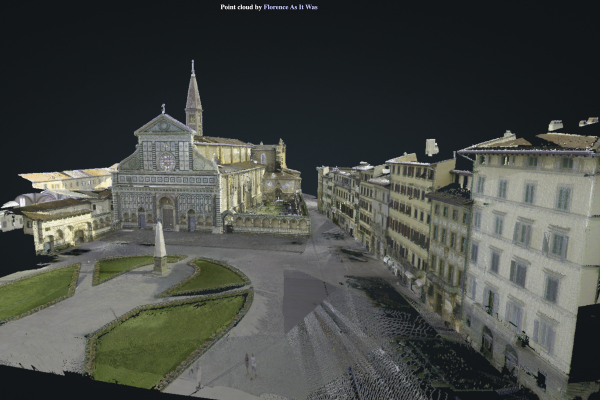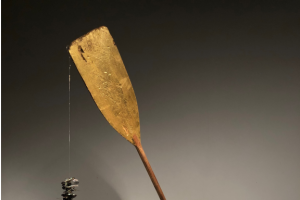
W&L’s Staniar Gallery Presents “Florence As It Was” The interactive exhibition will run from Feb. 13 through March 25.
Washington and Lee University’s Staniar Gallery is pleased to present “Florence As It Was: The Digital Reconstruction of a Renaissance City,” on view in the Lenfest Center for the Arts from Feb. 13 through March 25, with a lecture and reception slated for Feb. 13 at 5:30 p.m.
The exhibition and opening reception events are free and open to the public.
“Florence As It Was” is a digital humanities project that reconstructs the city of Florence, Italy as it appeared at the end of the 15th century and is produced by W&L faculty members George Bent, Sidney Gause Childress Professor of the Arts; David Pfaff, senior academic technologist and director of the IQ Center; and Mackenzie Brooks, associate professor and digital humanities librarian.
Bent, Pfaff and Brooks began the project in 2016, and with the assistance of more than 20 W&L students over the years, they have created point cloud models of more than two dozen architectural monuments in the city, using technologies that have not yet been embraced widely by cultural studies specialists, including geospatial referencing systems, LiDAR scanners, software programs to create navigable point clouds, and photogrammetry tools to produce 3D models of artwork.
Among the structures scanned, edited and modeled are the famous convents of Santa Croce and Santa Maria Novella, the Innocenti children’s hospital, and Filippo Brunelleschi’s famous double-shelled cupola that caps the Florentine Duomo. Photographic models of the paintings and sculptures that once adorned the monuments have also been included, with the original pieces having since been removed and reinstalled in various museums over the centuries.
“Nowhere else — outside of the city of Florence itself — can we experience the merging of architectural and artistic masterpieces of the early Italian Renaissance with such precision,” Bent said. “Presented here as an ensemble of cutting-edge computer-generated products, the spaces and images on view in this exhibition represent a dual exploration of both art history and digital design processes.”
The models represent years of research, editing and modeling, as well as on-site data collection conducted in some of the world’s most famous cultural sites — which Bent explains was both mentally and physically taxing work, as the team had to climb up flights of narrow stairs, crawl through dirt and dust, and navigate loose tiles on rooftops to capture this on-site data, all while carrying equipment in their arms or on their backs. “You have to stay alert, you have to be balanced, and you have to screw up your courage to go where you need to go to get good data,” he said.
An interactive exhibition, “Florence As It Was” speaks to W&L’s emphasis on interdisciplinary research and education. Innovative STEM techniques merge with traditional art historical inquiry to tell the story of 15th-century Florence, describe the technologies and processes involved in the reproduction of Florentine landmarks, and provide examples of computer-generated 3D models that may be explored by visitors to the exhibition. The students who have contributed to the project also demonstrate a range of academic interests and career ambitions, studying art history, Italian culture, English literature, computer science, geology, biology, business administration and German.
“Our students learn skills that are quickly becoming among the most highly sought-after by employers and academics,” Bent said. “They were already smart when they came to W&L, and they leave it with experience, wisdom and a vision for what the future might hold.”
Looking to the future, “Florence As It Was” is itself an important contribution to historical preservation, creating publicly accessible models of significant Florentine sites that can endure long after the monuments themselves.
“When a monument of cultural importance burns, it’s gone,” Bent said. “When it falls under the weight of a thousand years of history, it’s gone. When its supervisors, neighbors, and viewing public decide it is no longer worth preserving, it’s gone. Tuscany, being as it is on the top of a major seismic fissure that runs the length of the Italian peninsula, is due for a jolt from Mother Nature. The models we make of Florentine sites will permit future generations to inspect and study their appearance, design and foundational structure should disaster strike.”
“Florence As It Was” has received international support and recognition over the past eight years and has involved the work of over two dozen W&L students, as well as faculty advisers from academic institutions in the United States, Canada, Italy and Great Britain. The team recently received a grant from the Samuel H. Kress Foundation to support student research work, and the project was featured in a case study and documentary produced by Leica Geosystems, a Swiss surveying company whose 3D laser-scanning products have been used to create the digital reconstruction of Florence.
For more information about the 2023-24 exhibition and programming schedule, visit Staniar Gallery’s website.
Staniar Gallery is located on the second floor of Wilson Hall, in Washington and Lee University’s Lenfest Center for the Arts. When the campus is open to the public, gallery hours are Monday through Friday, 9 a.m. to 5 p.m. For more information, please call 540-458-8861.
 Digital reconstruction of Santa Maria Novella
Digital reconstruction of Santa Maria Novella


You must be logged in to post a comment.